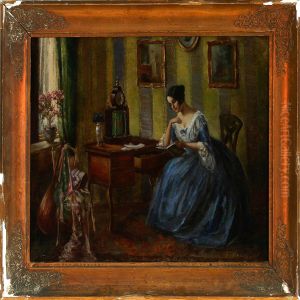Nina Karasek Paintings
Nina Karasek, born in 1870 in Austria, was a notable sculptor and artist whose work contributed to the art scene during the late 19th and early 20th centuries. While not as widely recognized as some of her contemporaries, Karasek's work reflects the artistic movements and social currents of her time.
Karasek was primarily known for her intricate sculptures. Although details of her early life and training are not well-documented, it is evident from her work that she possessed a deep understanding of the human form and a delicate touch in rendering it in various mediums. Her sculptures often depicted figures in a state of repose or contemplation, with a focus on capturing the subtleties of emotion and expression.
During her lifetime, Karasek was part of a vibrant community of artists and intellectuals. The turn of the century was a period of great change in the arts, with movements such as Art Nouveau and later Expressionism challenging traditional norms and aesthetics. Karasek's sculptures, with their fluid lines and emotive qualities, suggest that she was both influenced by and contributed to the Art Nouveau movement, which emphasized natural forms and structures.
Nina Karasek's career spanned a time of great social and political upheaval in Europe, including World War I and the significant changes in society that followed. It is likely that these events impacted her work and may have influenced the themes and tones she chose to explore in her art.
Karasek's death in 1926 marked the end of a career that, while perhaps not as celebrated as some of her peers, remains a testament to the rich and diverse artistic landscape of early 20th-century Europe. Her works continue to be of interest to art historians and collectors who seek to understand the breadth of influence and innovation during this dynamic period in art history.
